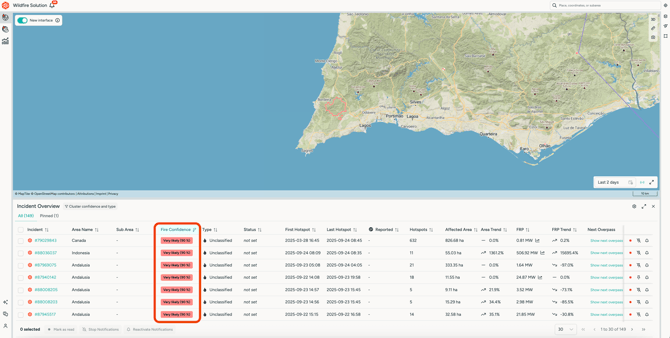Fire Confidence: Empowering your Decision Making
In this article, we'll cover:
1. Fire Confidence
The Fire Confidence metric was designed to indicate our certainty about whether a detected cluster truly represents a fire. This confidence level is calculated based on a range of key inputs, including local fire weather conditions, Fire Radiative Power (FRP), and data from various detecting satellites and algorithms. By merging these variables into one single metric, Fire Confidence offers a reliable tool to support your response strategies and prioritize incidents.
We use five categorical values to represent Fire Confidence:
- Not enough data (0%): Insufficient data available to determine fire likelihood.
- Unlikely (25%): Conditions and data suggest that a fire is unlikely.
- Indecisive (50%): Data indicates a possible fire, but certainty is limited.
- Likely (75%): Data strongly suggests that the cluster is a fire.
- Very likely (90%): High confidence that the cluster is a fire based on all parameters.
Below you can find an overview of all parameters used, and what they mean:

2. Locating Fire Confidence
Fire Confidence values are accessible through both the Cluster Menu and the Incident Overview. By viewing this metric in either section, you can quickly gauge the reliability of detected clusters, enhancing your situational awareness and decision-making.
- Via Clusters:

- Via Incident Overview:

Please note that the Fire Confidence parameters are not expandable via the Incident Overview. To have a deeper look you must do so by accessing each Cluster individually.
3. Using Fire Confidence for Decision Making
Fire Confidence is a critical tool to help prioritize responses based on certainty. For example:
- Low Confidence Levels (e.g., “Unlikely” or “Indecisive”) indicate that satellite information is not enough and additional data would be required before allocating resources.
- High Confidence Levels (e.g., “Likely” or “Very likely”) suggest that response teams should be on alert, as there’s a strong indication of fire.
In short, Fire Confidence is compiling all current data inside WFS to help you make informed choices, enabling quicker and more precise reactions based on data-backed assessments.
We strongly recommend reviewing individual clusters and expanding the Fire Confidence tab for a detailed view that goes beyond the broader summary offered by the Incident Overview.
This deeper insight allows you to assess the specifics of each cluster, providing a more comprehensive understanding crucial for effective response planning.

Example of high Fire Confidences with key metrics compared with low cluster confidence levels
